A magnificent hot spring inn that has been in operation for over a century.
This is proof that it has been supported by many hot spring lovers despite
being deep
in the mountains.
Let me say ......
"If you don't go take a dip while you're still alive, you're missing
out." |
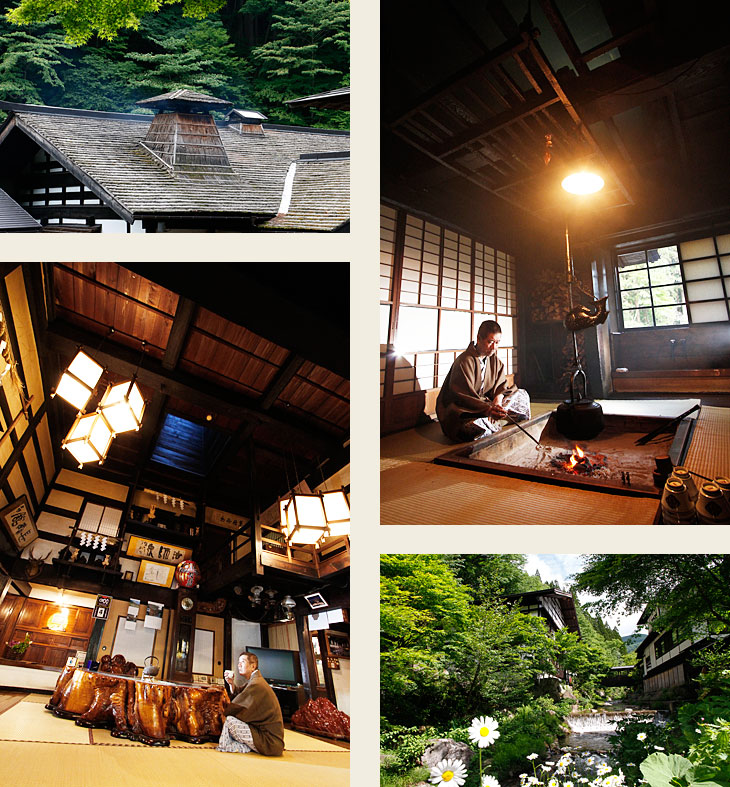 |
|
| "Here is the original scenery of good old Japan!" |
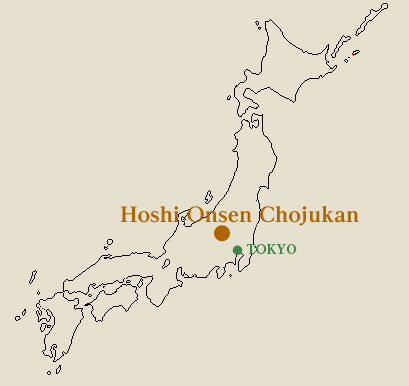 |
| Love at first sight in the form of an inn |
|
The owner of a hot spring inn told me, "Hoshi Onsen Chojukan has a
rich history that we can never duplicate.
It took me about three hours by motorcycle from Tokyo, and after a light
ride from the crowded city streets to the expressway, and a bee buzzing
against my helmet on the local road, I made my way deeper into the mountains.
It is a registered tangible cultural property. Just one glance at this
quaint, old-fashioned Japanese landscape will surely impress you. Especially
for city dwellers, it is irresistible. Although it is old, it looks fresh.
After checking in at an old-fashioned bookkeeper's office, I met the sixth
generations owner of the inn, who
has a long history since its establishment in 1875. I was expecting him
to be a strict and, with all due respect, dour person, but I was pleasantly
surprised and relieved to be greeted with a gentle smile.
In the corridor leading to my room, I saw a nostalgic full-moon poster
of Japan Railways (the predecessor of JR) from 1982. This is what I've
known about this inn for a long time, isn't it ? There is one more thing
on display in the inn's crossing corridor that would give a railroad enthusiast
like me goosebumps. It is a cross-sectional drawing of the Joetsu Line,
a 162.6km railroad line that runs through a series of 2000m-high peaks.
The drawing, also called a gradient mark, is dated 1894. Why are these
railroad plans here? We talked to the owner over a cup of tea at the sunken
hearth next to the entrance. Instead of talking about the hot spring, let's
talk about the railroad first.
The first owner of the inn established a railroad company to build the
Joetsu Line. But the company went bankrupt, and the inn was the only one
left standing, hahaha (laughs). He was an ancestor who drew up an extraordinary
plan in those days. Later, the government took over the project and opened
the railroad.
The inn is far from the nearest station, but it has always been visited
by many guests. Among them were some of Japan's greatest writers.
I can understand why the inn was popular with many literary giants because
of its elegant atmosphere and wonderful hot water. You can hear the murmuring
of the stream, the croaking of birds and frogs, and the refreshing sound
of the wind rustling the leaves. In such a natural environment, soaking
in the best hot spring water and writing in your room, you are sure to
produce good literature. |
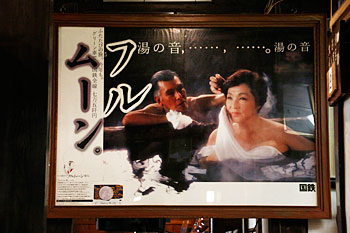 |
| A Japanese National Railways full-moon poster taken at Houshinoyu. The
inn allowed the photo to be taken on the condition that the name "Hoshi-no-yu"
not be mentioned, but it became widely known over time. |
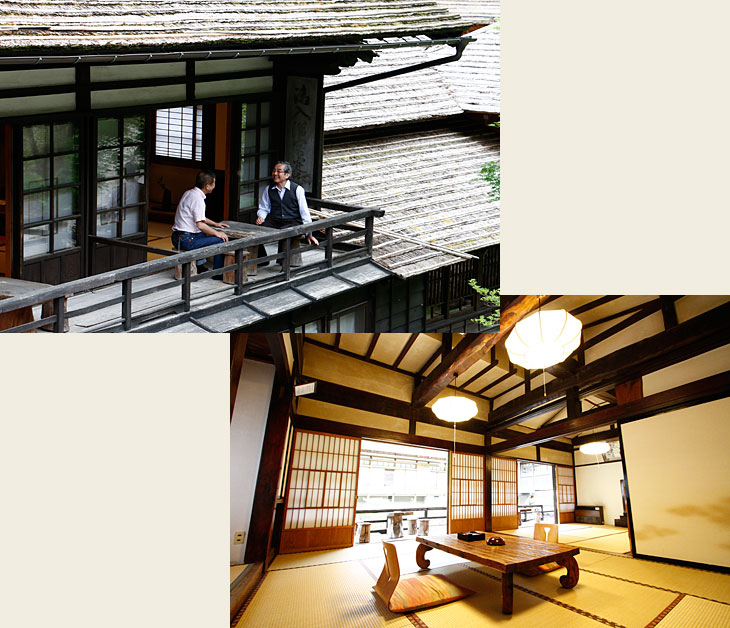 |
|
| This room has been loved by great writers since its establishment in 1875. I wondered what kind of works they wrote here. I had a conversation with the owner on the terrace. This is the atmosphere of ...... How beautiful the old Japanese architecture is ! |
| Better leave it to a specialist |
|
Each thing has its own profession and should be left to the experts. ......
"If you want to buy alcohol, you should go liquor shop. If you want
to buy rice cake, you should go rice cake shop". This is a Japanese
saying that has been handed down from generation to generation. I like
this saying, but it bothers me sometimes. I'm a writer, but my main business
is "making things," not "writing things." So I’m Phony
? That's what I sometimes think.
As I was starting to eat a delicious dinner made with endless local ingredients,
the owner came over. He was carrying four bottles of 720 ml sake. |
| Perhaps it is because I am a drinker, but the moment I saw the food, I
switched from beer to sake. Japanese mountain village delicacies go well
with Japanese sake. The onsen-loving drinkers will not be disappointed.
Of course, the food is also delicious, so even those who don't drink much
will be delighted. |
"Well, well, well, well. ……" Owner and I exchanged smiles, drank
a lot of Sake, and had a great conversation. At the time, I was thinking
of reporting it in this magazine, but the three of us, including the cameraman,
drank more than two liters, so I was in a daze. However, I remembered one
thing because I had written down every part of the conversation.
Hot springs and sake are similar," he said. You see, each of these
drinks has a different taste. Some are dry some are sweet. There are no
two hot springs in the country that have the same minerals, ingredients.
Now, how would you compare our hot spring to the taste of sake ? "
"Well, I would say it's an aged “maroyaka (mellow)".
Sake requires immaculate water. A true hot spring also needs pure water
from underground. ...... This is also what the owner said. So it seems
that the liquor store and the rice cake shop have something in common with
the hot spring. In both cases, "ripening" is important. I felt
that my two jobs were not entirely wrong. However, I am still far from
maturing.
We talked about railroads, literary giants, and sake, but we hadn't touched
on the important topic of hot springs. But this picture should be enough. "Oh, I feel so good !" I want to say with a big voice. |
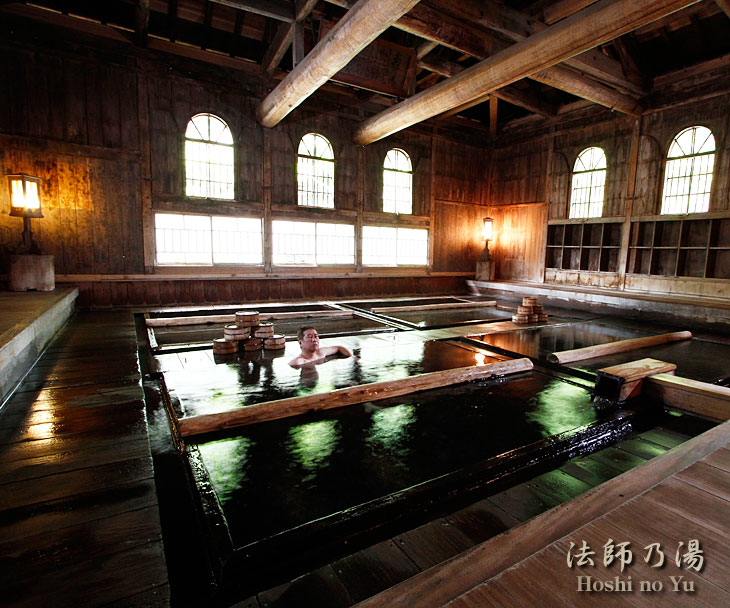 |
|
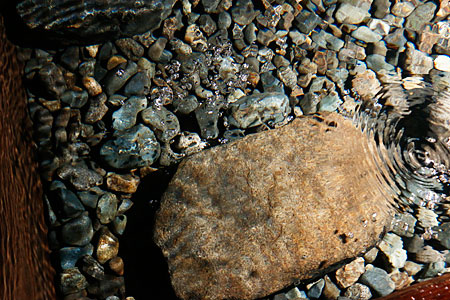 |
| The bottom of the bathtub at Hoshinoyu: It is said to have been gushing
out for 1,200 years, but at that time it was at the bottom of a river.
Today, pure and soft water still gushes out from under the stone with bubbles. |
The bottom of this bathtub is made of gravel and stones. The hot water
gushes out softly from underneath. which is filled with underground ingredients
from decades-old rainwater and melting snow, and is heated underground.
Of the 20,000 or so sources of hot spring water in Japan, there are only
about 20 or so places where hot water of the right temperature gushes directly
from the bottom of the bathtub. Also, because the hot spring water comes
from the bottom of the bathtub, the temperature cannot be altered. It is
neither high nor low temperature, and the temperature of this fountainhead
is about 42℃. The water in the bathtub is a little lower, maybe 40 degrees
Celsius, which is the result of a perfect coincidence.
The more than 120-year-old bathroom, which is also designated as a Tangible
Cultural Property of Japan, is also fantastic. As I looked up at the long,
thick beams on the ceiling, my eyes and skin felt the comfort of paradise.
From time to time, air bubbles greet you from the bottom of the bath, and
you can stay in the water forever.
...... "Oh, how good it feels !"
This is not the only bath in the inn. There are other unique baths in the
inn, so I decided to take a dip. |
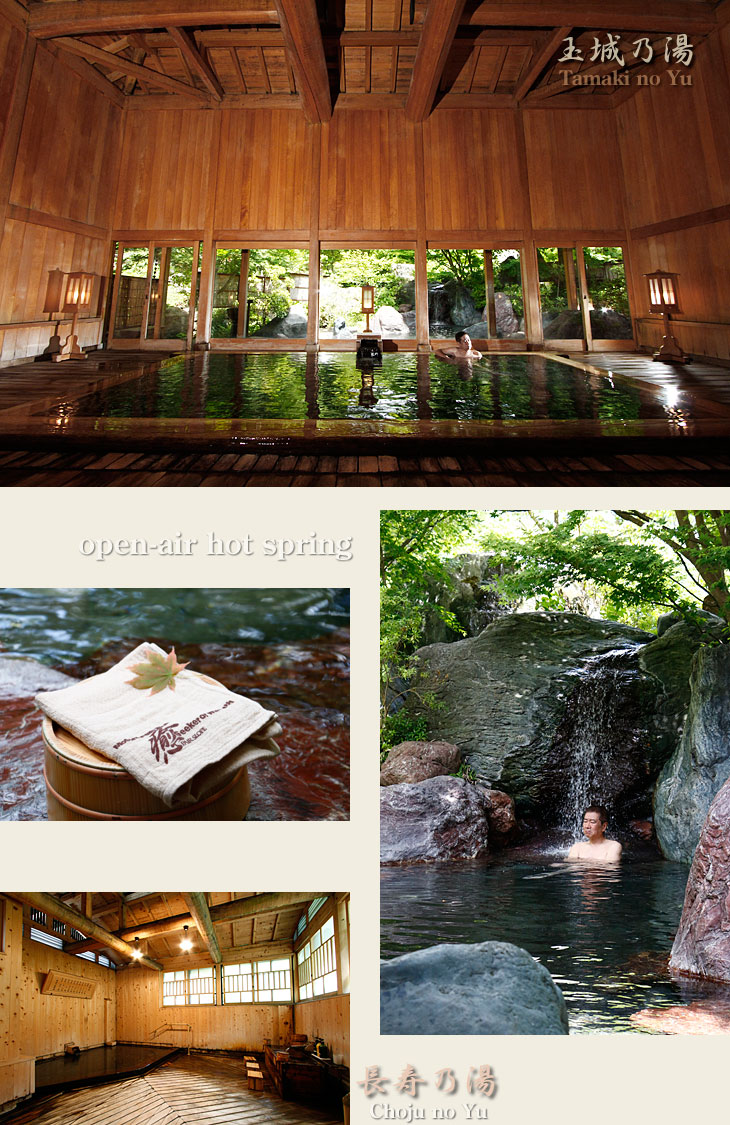 |
|
|
|
| The Spirit of a Yumori |
|
As the name implies, a "yumori" is a person who protects the
hot water. However, the owner of the inn told me that his job is not limited
to just maintaining and managing the inn's bathtubs.
In the late 1980s, a dam and a large ski resort were planned to be built
in this area. The construction of the dam would change the underground
water source. The construction of the ski resort will change the environment
of the water resources by cutting down the forest. The source of the village's
water supply had already been changed, and the villagers were troubled
by the muddy, unpalatable water.
Then one day, owner saw a golden eagle flying around. The golden eagle
is a national natural monument (a rare species of wild animal and plant
in Japan), and development in the area is restricted. So, owner took the
lead and with the cooperation of the Nature Conservation Society of Japan,
confirmed that golden eagles live in the area, as well as hawk eagles.
It took about ten years to stop the dam and ski resort project.
He smiled and said,
"If we blame it on the birds, no one will be bothered, ha-ha-ha,"
but it took a great deal of vision and effort to protect the hot spring
water of Hoshi Onsen, which was handed down from our ancestors. What do
you think, do you want to take a dip in this historic hot spring that has
been cherished by the owners for generations ? |
|
 |
|
| The master tends to his Katana. He has a scary serious expression on his
face, which is completely different from when he is talking to me. The
replica is on display at the inn. |
|
|
|
|
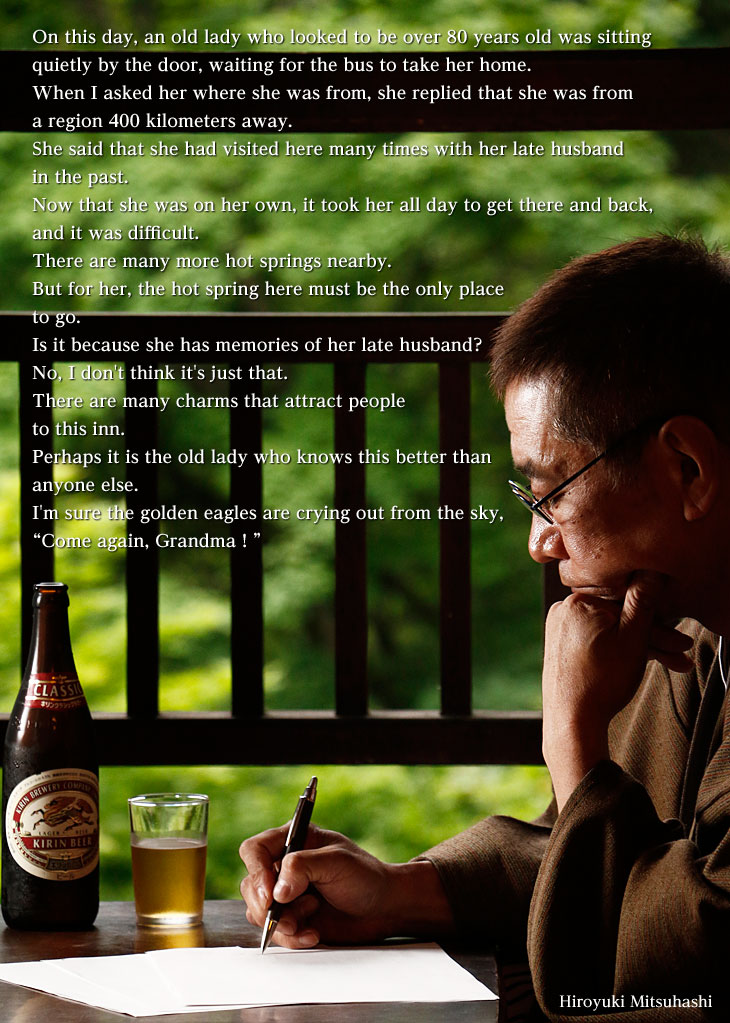 |
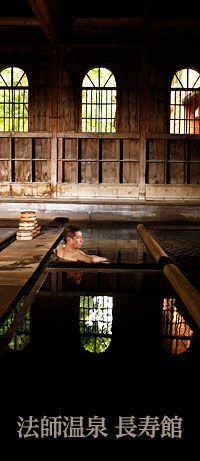 |
|
Hoshi Onsen Chojukan
650 Nagai, Minakami Town, Tone Gun, Gumma Prefecture
TEL 0278-66-0005
Rates start from 20,500 JPY per person on weekdays
(tax included for a double occupancy room).
Total 34 rooms.
English conversation is available at the inn.
[Hot Spring]
Hoshinoyu/Choujyounoyu: Calcium sodium sulfate
hot spring 41.5 ℃ pH8.5 Alkaline
Tamaki-no-yu (inner hot water): Mixed spring of the above-mentioned hot
spring and a simple hot spring (28 ℃) pH8.5 alkaline
Tamaki-no-yu (open-air): Simple hot spring 28 ℃ pH8.5 alkaline
Number of springs: 3 (Natural gush 2 / Excavation selfexplosion 1) Private
fountainhead
Total gush volume: 433 L/min
Fountainhead free-flowing water No additional water and no heating There
is circulation heating for hot water temperature maintenance in Tamaki-no-yu.
Bathroom: Mixed bathing 1 (There is a female time), an inner hot water
with open-air 1 (man and woman alternation system), and an inner hot water
1 (man and woman alternation system)
[Inn data] As of December, 2021
Official site http://hoshi-onsen.com/english/index.html |
|